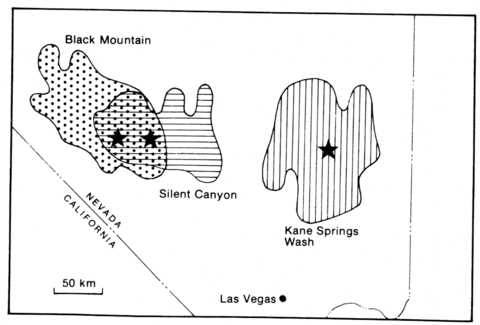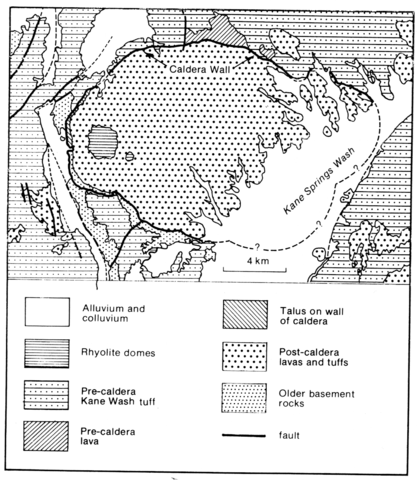stripes
Lying east of the Black Mountain and Silent Canyon volcanic centres Kane Springs Wash is the source of the Kane Wash tuff which covered an area of 7500-10 000 km2 and had an original volume of more than 800 km3. Volcanic activity at the centre started with the eruption of lavas which were followed by the Kane Wash tuff which comprises at least six and possibly as many as 12 ash-flow sheets. Collapse produced a caldera with a maximum diameter of 18 km, there being an overlap in time of caldera collapse and tuff eruption such that the caldera was completely filled by later ash-flow deposits. Later lavas, including mafic varieties, were erupted and cut by rhyolite domes. Novak (1984) gives a detailed stratigraphic account of the centre. A high proportion of the rocks of the centre are peralkaline, mainly comendites, but include trachytic soda rhyolite and trachyte, basalt and silicic rocks without peralkaline affinities. The comendites have phenocrysts of sodic sanidine, iron-rich clinopyroxene, fayalite and sometimes quartz; plagioclase, biotite and hornblende are absent or very rare. Arfvedsonite, or less commonly riebeckite, occur in the groundmass and gas cavities. Dykes up to 12 m thick rich in carbonate (40-55%) intrude tuffs near the top of the Kane Wash Formation (Tieh and Cook, 1971), but their mineralogy and chemistry seem to preclude them being carbonatite. A range of rock analyses are given by Novak (1984, Table 2).
SARGENT, K.A., NOBLE, D.C. and EKREN, E.B. 1965. Belted Range Tuff of Nye and Lincoln Counties, Nevada. Bulletin, United States Geological Survey, 1224-A: 32-6.
NOBLE, D.C. 1968b. Kane Springs Wash volcanic centre, Lincoln County, Nevada. Memoir, Geological Society of America, 110: 109-16.
NOVAK, S.W. 1984. Eruptive history of the rhyolitic Kane Springs Wash volcanic center, Nevada. Journal of Geophysical Research, 89B: 8603-15.
TIEH, T.T. and COOK, E. 1971. Carbonate-rich dikes in ignimbrites of southeastern Nevada. Bulletin of the Geological Society of America, 82: 1293-1304


